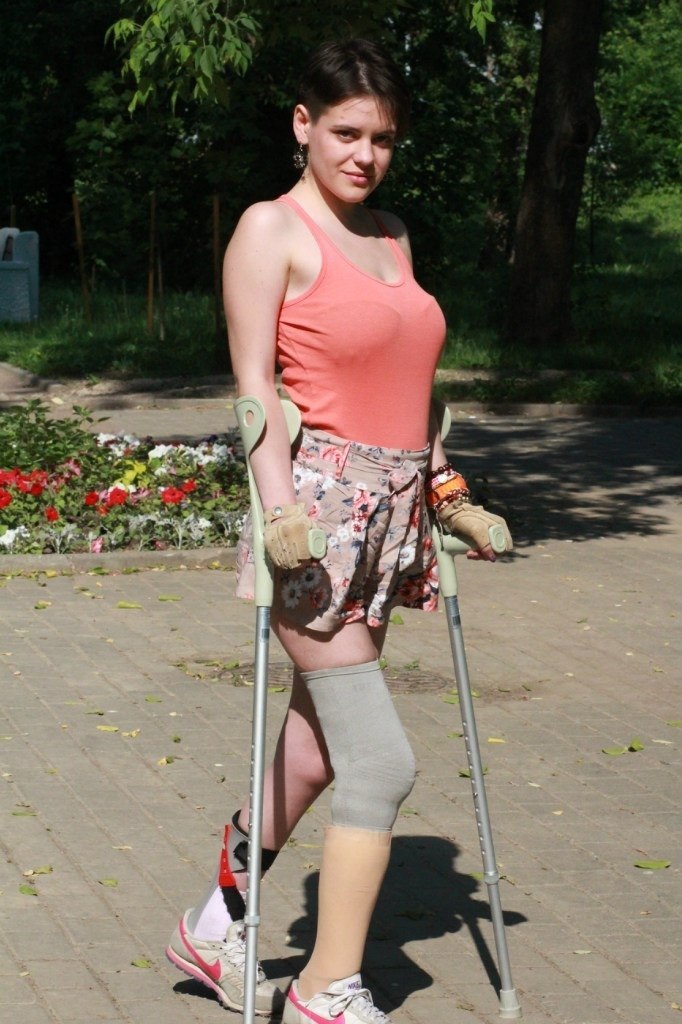CELEBRATING
13+ YEARS
SAFE & SECURE
CHECKOUT
PRIVACY
ASSURED
75K+ HAPPY
CUSTOMERS
FREE
SHIPPING
FREE EASY
RETURNS
If you're experiencing tiredness from using your crutches, there are a few things you can do to make sure you're using your crutches optimally. If you're wondering how to use crutches without pain, the following tips should come in hand as well.
Here are some things to keep an eye on:
|
First, you must have the correct crutch pair size. There are three sizes: youth, adult, and tall adult.
Using the wrong crutch size will not allow you to adjust its size correctly.
Once you've made sure you have the correct crutch pair, it's time to adjust them to fit your size.
Proper Crutch AdjustmentUsing crutches that are not properly adjusted to you is one of the main reasons for discomfort.
If the crutches are set too high, it can put significant strain on your armpits. Crutches that are set too low can cause you to hunch over and hurt your back.
The key rule is to have about a two-inch space between the top of the crutch and your armpit while you stand straight.
Then, the crutch handles need to be leveled with your wrists.
Finally, while standing straight and holding onto the handles, your elbows should be bent very slightly .
Learn how to adjust your crutches:
Walking with Crutches ProperlyUsing your crutches properly is key to minimizing pain and discomfort, and also avoiding tripping or falling.
Depending on which stage of weight-bearing you are, you'll have to do a different walking procedure.
Typical weight-bearing stages include:
| • non-weight bearing (absolutely no weight put on your injured foot) • toe-touch weight-bearing (you can touch your toe on the ground) • partial weight-bearing (enough weight you feel comfortable at) |
Check out this video on the different ways to walk with crutches according to your weight-bearing stage:
|
If you tried all the above and you're still unhappy with your crutches, you should consider some popular crutch alternative like an iWalk or a knee scooter.
Crutches are the most recommended mobility option because they can be inexpensive and very widely available. But...
But...
Knee scooters are the most popular alternative to crutches.
A knee scooter allows you to keep non-weight bearing by resting your injured leg on a knee pad, then you roll and steer towards the direction you want to go.
It's the most effortless mobility device you'll ever use. And the best thing about them is you can "park" it and have both your hands free to do whatever you need to do. This is something you cannot do at all with crutches.
If you have a below-the-knee injury and want to get around faster and independently, you should consider getting a knee scooter.Further Reading: How to Choose the Right Knee Scooter for You
How do you make crutches easier?Many people who use crutches express frustration on how physically demanding and uncomfortable crutches are to use.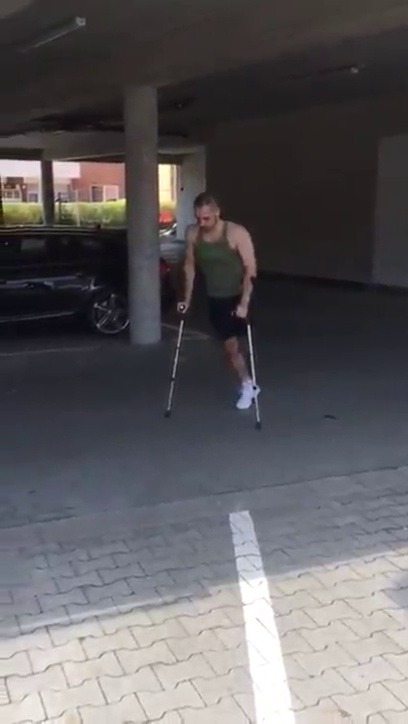
Unfortunately, these disadvantages are inherent of their design. You're supporting yourself on two sticks, after all.
•
•
•
•
Phone: 877-520-3708
Chat with us instantly >
* For discussion purposes only, your email address will not be shared, distributed or used to solicit any unwanted information.
Knowing you have weeks or months left on them isn’t encouraging, but thankfully, there are ways to make your crutches more bearable while you recover. If you’re facing down several more weeks or months on crutches, take some time to learn how to cushion your crutches to make them more comfortable or consider how a crutch alternative might reduce or eliminate your pain while you recover.
There are several easy methods for making your crutches more comfortable, including learning how to cushion them, using cushioning grips, properly using and adjusting your crutches, and even finding a more comfortable alternative.
Crutches don’t offer much in the way of cushioning, so learning how to cushion your crutches is one of the best places to start when it comes to making them more comfortable.
You don’t have to look far to find some good padding. The easiest way to add cushioning simply involves some old towels and duct tape. You can use any type of fabric, as long as it will provide cushioning and make your crutches more comfortable.
Simply fold your old towel (or blanket) so it’s just wider than the top cushion of your crutch. Wrap the fabric around the top of the crutch and secure it with duct tape. Make sure your padding doesn’t shift or roll while you use your crutches. If your padding moves, it can increase your risk of falling or cause additional discomfort.
Alternatively, you can add padding underneath some crutch cushions. Fabric or padding can be stuffed under your existing cushion to make it more comfortable. If your crutch cushion won’t allow you to add padding or your DIY fabric cushion keeps shifting, consider investing in some commercial crutch pads or a crutch alternative.
Crutches aren’t just potentially painful for your arms, they also make your hands tired and sore because you place a lot of weight on your hands while you get around. Adding additional padding or grip to your crutch grips can make it easier on your hands.
You can employ the same technique as cushioning your crutches by using rolled-up fabric and duct tape on the grips. However, if the padding rolls or moves, it can make your crutches dangerous to use and increase your risk of falling. The best way to cushion this area is to purchase crutch grips that won’t shift around, which reduces the impact on your hands.
Even if you know how to cushion your crutches, they can still be painful if they aren’t properly adjusted to your body. Crutch pads that are too tall will dig into your armpits and ones that are too short will affect your posture. Even if you purchase crutches that are suitable for your height range, they may not be adjusted for you.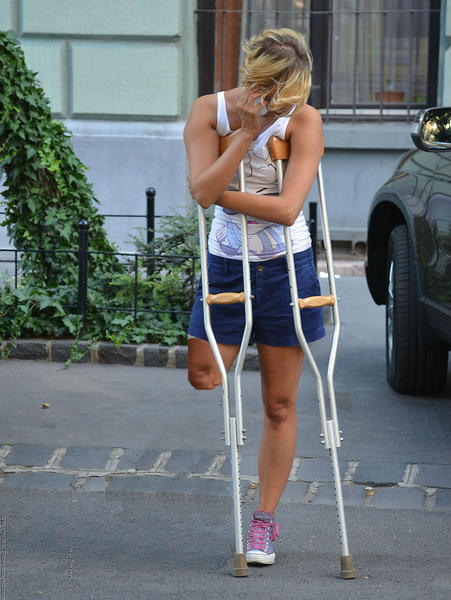
Properly fitting crutches should not dig into your armpits. To adjust your crutches, place the foot of the crutch a few inches in front of your feet. In this position, the crutch pads should hit about two inches below your armpits.
Once you’ve adjusted the crutch height, check the grips. With the tops of your crutch about two inches below your armpits, your elbows should have a slight bend and wrists should be straight and aligned with your hips. Adjust your grips accordingly for the correct fit.
For hands-free crutches like the iWALK2.0, you’ll need to adjust the height, leg straps, and angle of your mobility device to get the perfect fit.
Fortunately…
With a hands-free crutch, there’s no need to worry about underarm or hand pain.
The quickest way to experience pain while using crutches is to use them improperly.
Proper use of your crutches will keep both your good and injured leg protected from damage. If you’re experiencing wrist or hand pain, it can mean you’re putting too much of your weight on your hands. Make sure your elbow has a slight bend and you’re not bending your wrists. Bent wrists are more susceptible to pain or injury.
If you’re experiencing wrist or hand pain, it can mean you’re putting too much of your weight on your hands. Make sure your elbow has a slight bend and you’re not bending your wrists. Bent wrists are more susceptible to pain or injury.
To walk correctly with crutches, start by standing on your good leg. Swing your legs forward, landing on your good leg, then move your crutches slightly ahead of you and continue this motion to get around. Make sure you keep your knees slightly bent to prevent excessive impact on your joints.
Hands-free crutches like the iWALK2.0 require a little practice but allow you to maintain the same gait that you would normally have on two legs.
The truth is, no matter how much you’ve learned about how to cushion your crutches or adjust them, they will never be perfectly comfortable to use. If you just can’t get your crutches to work for you, it may be time to consider a crutch alternative. Here are some common alternatives you might consider if regular crutches leave you in pain.
Learning how to cushion crutches can help make your time in recovery more bearable, but sometimes no amount of cushioning can make up for how uncomfortable crutches are.
Take time to rest so you aren’t constantly on your crutches, or find an alternative to crutches that can help make your recovery easier. Compare mobility devices and find out which mobility device is best for your needs. find out which mobility device is best for your needs.
Crutches are used to improve coordination and reduce stress on the legs by increasing support and transferring body weight to the upper torso and arms.
Elbow crutches
These crutches with an emphasis on the forearm serve as a support when walking for a person with injured or sore legs. The crutch looks like a high cane, reaching to the elbow joint and topped with a special flexible cuff. They are made of aluminum and have a stand, an emphasis-clamp and a handle. The height of the "Canadian" elbow crutches must correspond to the person's height. The height of all underarm "Canadian" crutches can be adjusted. Although crutches of this type provide insufficient lateral support, they are smaller in size, more functional when climbing stairs.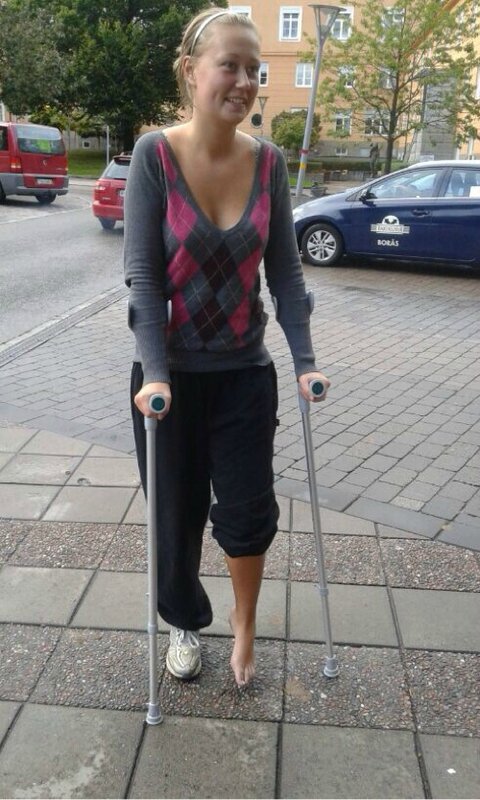 They can be used simultaneously with orthopedic appliances.
They can be used simultaneously with orthopedic appliances.
Instruction manual for learning to walk on underarm (Canadian) crutches
The use of crutches requires fairly good balance and coordination, as well as muscle strength. Therefore, it is preferable to use crutches for "young" patients for a short period of time.
A. You can start training only when the sick or injured person is already sitting with his legs down and gets out of bed on a healthy leg with the help of a support (headboard, table, etc.)
B. Before you stand on crutches, you need to adjust them (the design of the crutch allows you to set the desired length). You need to know how to properly hold the crutch:
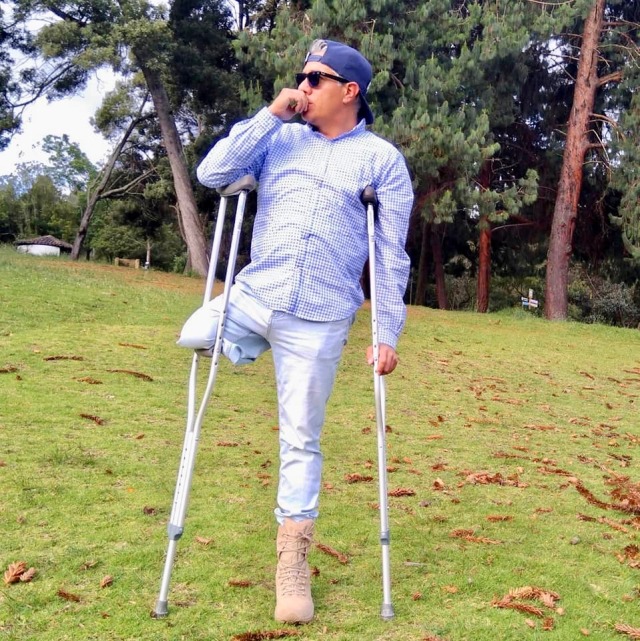
B. How to walk on crutches.
Insurance is required at all stages of training.
1. The patient stands on a healthy leg, holding on to a support, for example, a rectangular table, with one hand, and a crutch with the other.
Then:
2. The patient stands on a healthy leg, crutches are in both hands.
Then he:

3. In the future, you can move on to walking when both crutches are brought forward at the same time.
When a person is standing with two crutches, they should be slightly apart - this gives the person more stability.
Axillary crutches
Made from lightweight wood or aluminium. Their design usually includes a platform for armpit support, a handle, a double bar that goes from below into one stand with a rubber tip with a diameter of 3-8 cm. Crutches may have clamps, screws or other devices that adjust their height.
Axillary crutches
They serve as a support when walking for a person with injured or sore legs.
The height of the axillary crutches must correspond to the height of the person. The height of all axillary crutches can be adjusted.
To determine the correct height, there are two reference points: the axillary bar should be 4-5 cm below the armpit
The method for determining the correct selection of the height of the crossbar for support with a brush is as follows: in a standing position, with arms extended along the body, the handle of the crutch should reach the level of the watch on the wrist.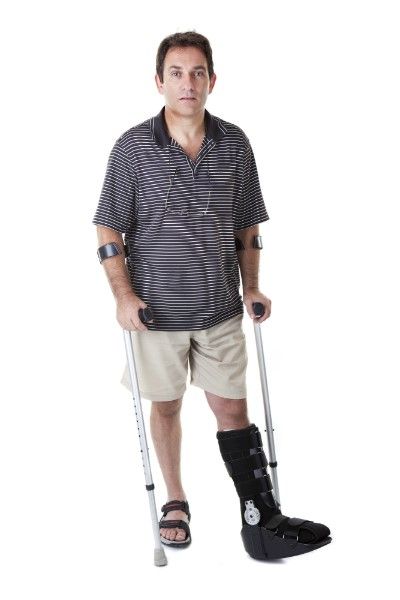 Note: The use of crutches requires fairly good balance and coordination, as well as muscle strength. Therefore, it is preferable to use crutches for "young" patients for a short period of time.
Note: The use of crutches requires fairly good balance and coordination, as well as muscle strength. Therefore, it is preferable to use crutches for "young" patients for a short period of time.
A. You can start training only when the sick or injured person can already sit with his legs down and get out of bed on a healthy leg with the help of a support (headboard, table, etc.)
B. Before you stand on crutches, you need to adjust them (the design of the crutch allows you to set the desired length). You need to know how to properly hold the crutch: The upper part of the crutch should not rest against the armpit. The gap should be two fingers wide. The back of the person on crutches should be as straight as possible. The armrest of the crutch should be positioned so that there is an angle of approximately ten degrees at the elbow joint.
B. How to walk on crutches:
1. At all stages of training, safety net is necessary;
2.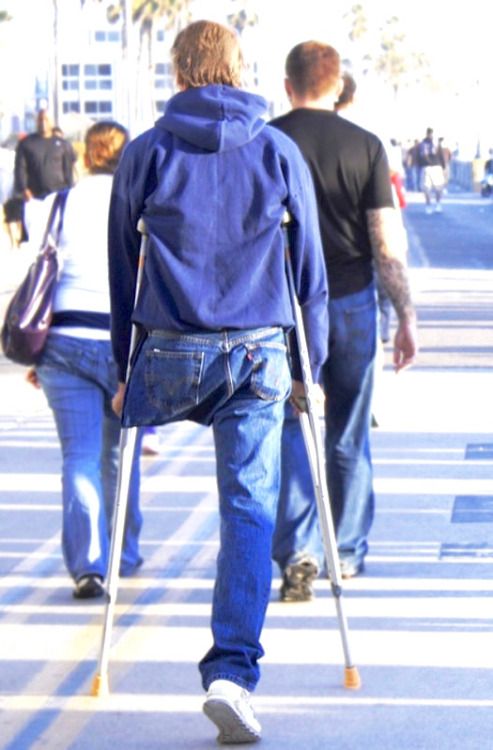 The patient stands on a healthy leg, holding on to a support, for example, a rectangular table, with one hand, and a crutch with the other.
The patient stands on a healthy leg, holding on to a support, for example, a rectangular table, with one hand, and a crutch with the other.
Then:
3. The patient stands on a healthy leg, crutches are in both hands.
Then he:
4. In the future, you can move on to walking when both crutches are brought forward at the same time.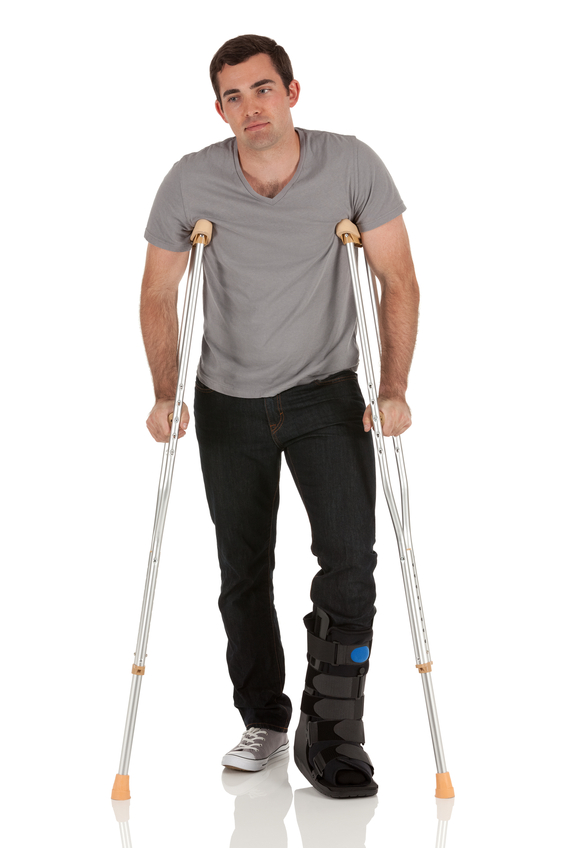
When a person is standing with two crutches, they should be slightly apart - this gives the person more stability.
When using crutches of various types, remember that:
The best position of the patient: the head is raised high, the back is straight, the healthy knee is slightly bent. For support, you can lean your back against the wall. The tips of the crutches are placed about 15 cm from the toes and slightly forward. If the patient has wide hips, it is better to move the tips to the side for a greater distance. The distance between the armpit and the top of the crutches should be about 2-3 fingers. The elbows are bent at an angle of 25-30 .. With a push, you can check whether the body easily comes off the floor. The arms should be almost straight. Crutch tolerance is tested during the walk.
The distance between the armpit and the top of the crutches should be about 2-3 fingers. The elbows are bent at an angle of 25-30 .. With a push, you can check whether the body easily comes off the floor. The arms should be almost straight. Crutch tolerance is tested during the walk.
In order to get up from a chair, crutches folded together are placed on the injured side and grasped from the inside. Then they throw them with the other hand over the chair, straighten the healthy leg.
To sit down, repeat the same movements, starting with placing two crutches on the injured side. Then the patient straightens his back and sits down. At the same time, he must be sure that the chair or chair does not swing.
When walking with crutches, both crutches are placed simultaneously 30 cm in front and 15-20 cm towards the toes. They carry, leaning on the handles, the weight of the body forward. You can swing on crutches. Land on the heel so that the crutches are behind the patient.
The shuttle gait is the easiest and safest for those who are starting to use crutches. You need to start by bringing the crutches forward, transfer the weight of the body forward, leaning on your hands, and slide in the same direction with your healthy leg.
When going up or down stairs, you can use the following method. The patient takes both crutches under one arm, holds them from the inside with his thumb. The other hand grabs the railing (hand slightly in front of the body).
When lifting, the crutches are left at the level where they stand. Then evenly distribute the body weight on the hand holding the crutch and on the railing. Raise the good leg up the step, leaving the bad leg behind, straighten the good leg and move the crutches forward.
When descending from the steps, crutches are placed on the lower step and the sore leg is pulled out. Then they evenly lean on the hand holding the crutches and on the railing.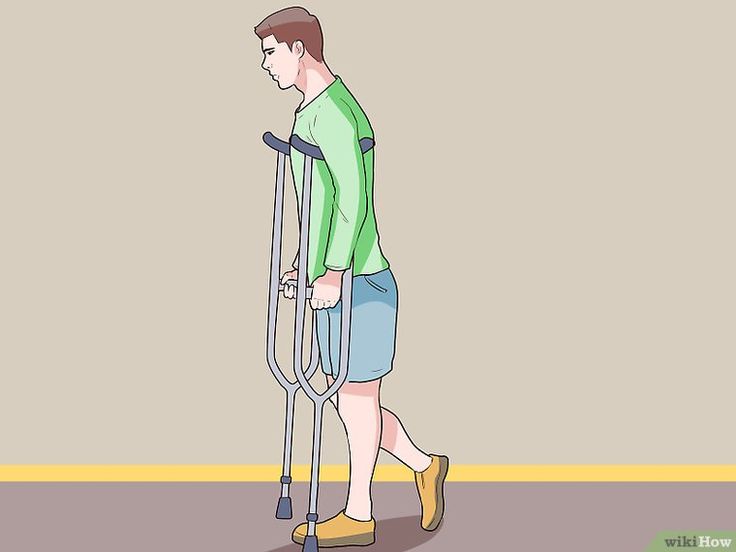 Move the healthy leg forward to the lower step. It is recommended to use this method when descending or ascending narrow stairs.
Move the healthy leg forward to the lower step. It is recommended to use this method when descending or ascending narrow stairs.
Go to section Crutches
Tags: Rehabilitation crutches Question/Answer
Product code #0178
Free shipping
Discount
Product with video
Goods with 3d
1 490 ₽
Buy
Add to Favorites Favorite +Compare +Add to comparison list
Product code #0177
Free shipping
Discount
From 990 ₽
Buy
Add to Favorites Favorite +Compare +Add to comparison list
Product code #0138
Free shipping
Bestseller
2 400 ₽
Buy
Add to Favorites Favorite +Compare +Add to comparison list
Product code #7564
Free shipping
Discount
1 050 ₽
Buy
Add to Favorites Favorite +Compare +Add to comparison list
Product code #0170
Free shipping
Product with video
Goods with 3d
4 590 ₽
Buy
Add to Favorites Favorite +Compare +Add to comparison list
Product code #1568
Free shipping
Product with video
2 990 ₽
Buy
Add to Favorites Favorite +Compare +Add to comparison list
Product code #5374
Free shipping
Discount
Product with video
From 1 790 ₽
Buy
Add to Favorites Favorite +Compare +Add to comparison list
Product code #5375
Free shipping
Discount
1 990 ₽
Buy
Add to Favorites Favorite +Compare +Add to comparison list
Product code #0152
Free shipping
Bestseller
3 100 ₽
Buy
Add to Favorites Favorite +Compare +Add to comparison list
← Back to news list
Items in your cart:
Go to cart
Continue shopping
Dear !
Thank you, your order no.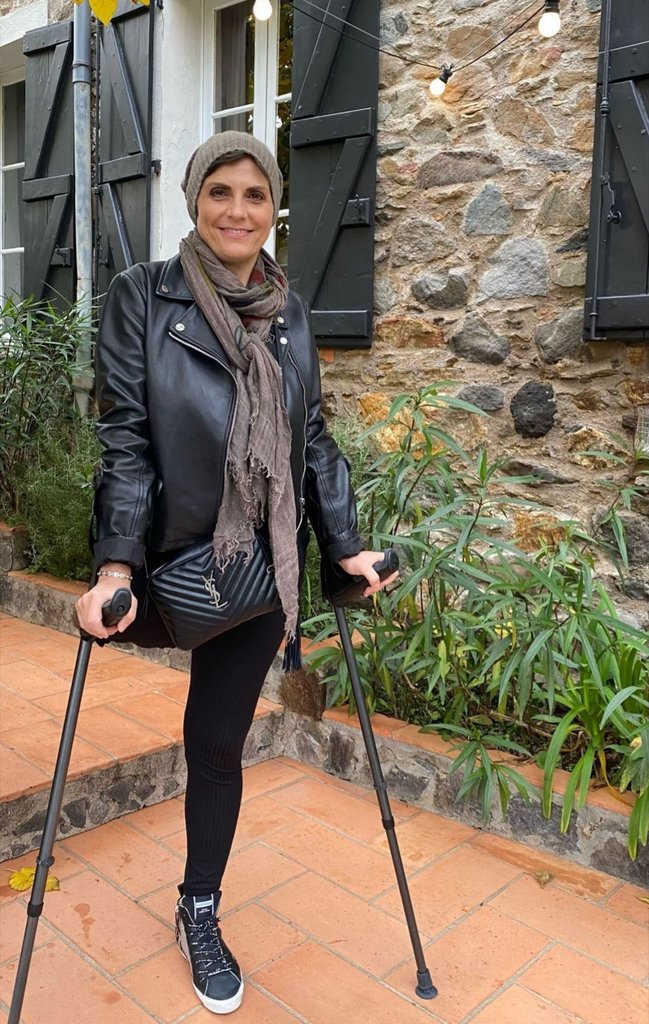
In the near future our manager will contact you to confirm the order.
Order confirmation is carried out daily from 9:00 to 18:00 (Moscow time).
The manager will call you back, clarify all the details and place an order in your name.
Name
Telephone
Place an order
By clicking the "Place an order" button, I give my consent to the processing of personal data in according to the conditions specified here.
SMS with shop address sent
You are interested in the store address:
Telephone
By clicking the "Send SMS" button, I give my consent to the processing of personal data in according to the conditions specified here.
Send SMS
Close
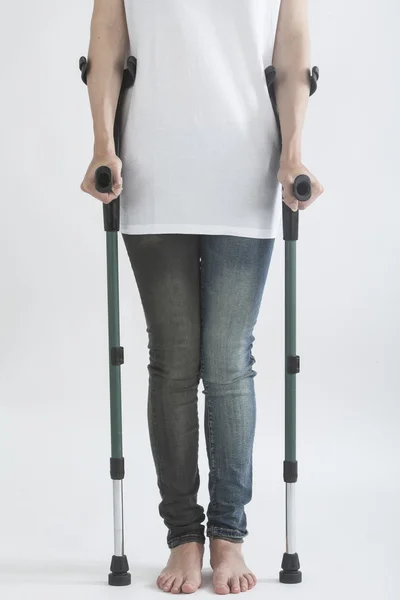
In Russia, except for bulky goods*:
The calculation of the delivery of bulky goods is made in the process of placing an order on the website or when the order is confirmed by the operator.
more
All goods in MED-MAGAZIN.RU are certified, and their quality is confirmed by the necessary documents. If for any reason you want to exchange or return the purchased goods, then subject to all the conditions and rules established by the legislation of the Russian Federation, we will exchange the goods or refund your money.
Items purchased in our online store, you can return or exchange within 7 days from the date of receipt.
If the product was purchased in one of our retail stores, it can be returned or exchanged within 14 days from the date of purchase.
In Moscow, within the Moscow Ring Road, you can use the service of free return of goods by courier.
more
None of us is immune from injuries that make it impossible to move independently. But you can keep the ability to move without outside help during the restoration of health - with the help of crutches. We will tell you how to walk on crutches correctly, because movement is a necessity.
There are different crutches, each type is designed for a specific situation: for movement after surgery, for rehabilitation stages, after amputation, leg fracture. In general, their appointment is associated with foot problems. If the doctor gave the green light to the possibility of loading the sore leg, then the first rehabilitation stage can begin.
You must first choose shoes for walking on crutches. Well, when it will be familiar to you.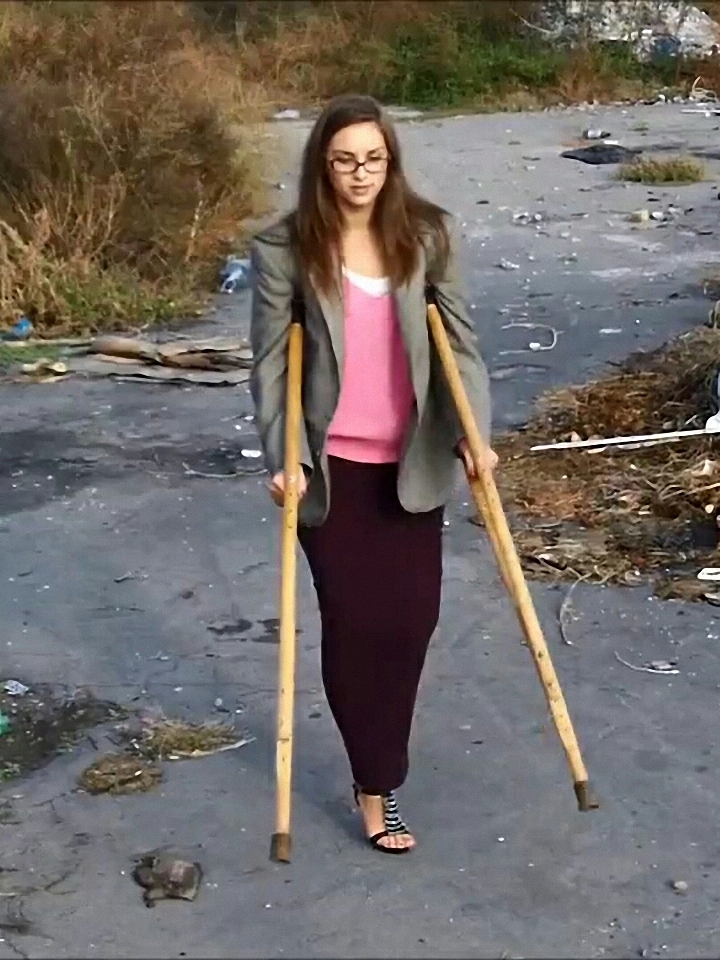 If you have to buy a new one, then you need to buy a cloth one with a rubber, elastic, non-slip sole without heels. There should be an orthopedic insole: the foot “breathes” in it, does not sweat, and this frees you from frequent changing shoes. After all, in order to change shoes, you need to sit down, and on crutches such an action will be difficult. Shoes should be without lacing, without unnecessary decorative elements, so that they can be easily put on and taken off. In summer it can be just slippers, in winter - shoes with insulation. You can buy a long spatula for the convenience of self-shoeing.
If you have to buy a new one, then you need to buy a cloth one with a rubber, elastic, non-slip sole without heels. There should be an orthopedic insole: the foot “breathes” in it, does not sweat, and this frees you from frequent changing shoes. After all, in order to change shoes, you need to sit down, and on crutches such an action will be difficult. Shoes should be without lacing, without unnecessary decorative elements, so that they can be easily put on and taken off. In summer it can be just slippers, in winter - shoes with insulation. You can buy a long spatula for the convenience of self-shoeing.
Walking on crutches, look at the road and choose a more even one, without puddles and mud, without stones. Do not go into the sand, on loose earth. You shouldn’t walk on the grass either: you can’t see holes and bumps in it, if you don’t successfully lean on the crutch, you can just lose balance and fall. Asphalt is the best option, but only flat without steep ascents and descents. In wet weather or in winter, beware of slipping, and not only with your foot, but also with a support.
In wet weather or in winter, beware of slipping, and not only with your foot, but also with a support.
When walking down the street or long walks on crutches, do not try to cover the distance as quickly as possible. Fatigue is your burden. This is especially dangerous when you are walking far alone and there is no one around to help you up. Don't be heroic, even if you're a champion runner, always take a break. Tired is not only a healthy leg, but also the arms, and the whole body, especially the lower back, back and hip joint. When walking on crutches, all the muscles of the body make unusual contractions and tensions.
Well, if you have strong arm muscles, then walking on crutches will not be too much of a problem. If you are not a trained person, then choose the axillary type of crutches, elbow crutches in this case will not work, unless the injury is simple. But the arm model must still be used until the leg is restored to such a state that, at least slowly, but you can walk without crutches for anything, without holding on.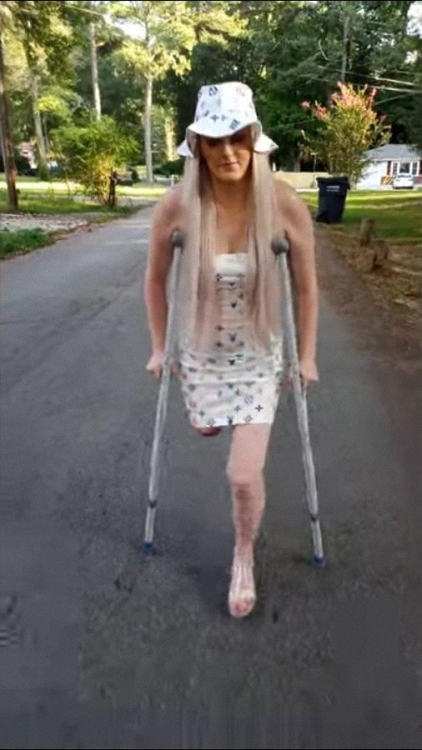 Another thing is when you are a very old person, and it is difficult and uncertain to move around. In this case, you need a walker.
Another thing is when you are a very old person, and it is difficult and uncertain to move around. In this case, you need a walker.
There is probably no person who does not know what crutches look like. They are always associated with the axillae. It's kind of a classic. Axillary crutches are used both in pairs and relying on only one. It always depends on the complexity of the injury or on the ability to walk with both feet in general. After the amputation of the leg, axillary crutches can never be dispensed with.
After a broken leg and in another unfortunate case, it is important to choose the right axillary crutches for the disabled. The most important criterion is height. And not only the entire length, but also the distance from the axillary crossbar to the supporting arm for the hand. It is necessary to select these sizes so that, taking the crutches in the armpits, the arms are slightly bent at the elbows, and the supporting leg is fully extended with all the load of the body on it.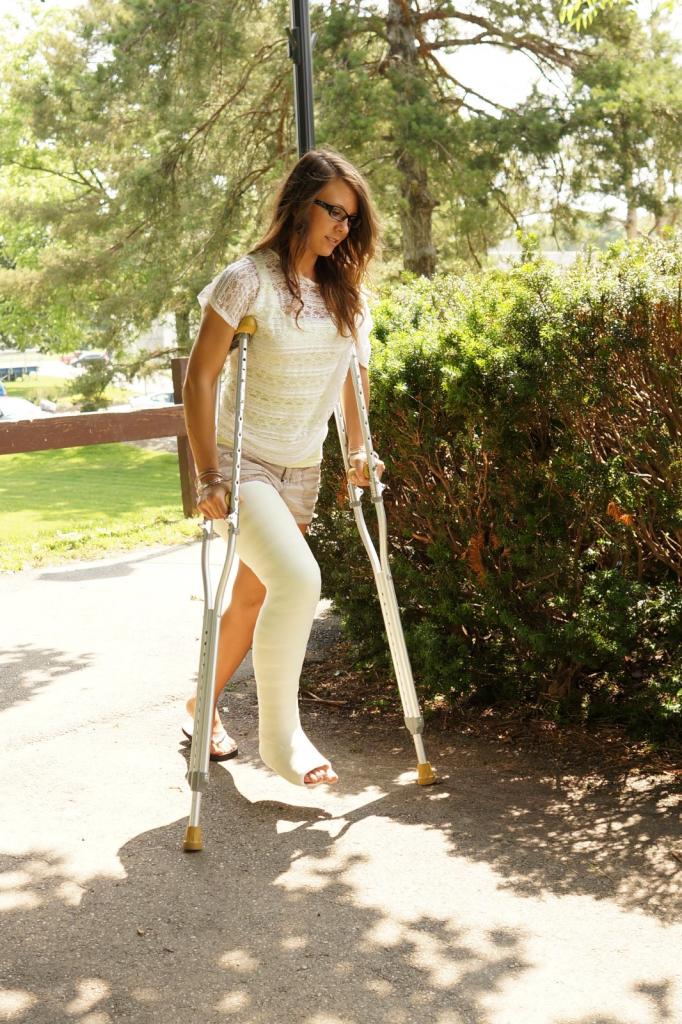
There must be a soft pad on the underarm bar. Usually it is foam rubber in a leatherette case. In new models, new materials are also used - soft, elastic, resistant to abrasion, moisture. Silicone has all these qualities. Rubber though soft, but its softness is relative to armpits. Rubber pads should be on the crossbars for the hands.
Speaking in numbers, the height is calculated from the height of a person in centimeters minus 40 cm. This means that if your height is 180 cm, then the total height of the crutches should be 140 cm. The height of the sole of the shoe is taken into account in calculating the height of a person. As we have already said, heels are not prescribed for shoes with a foot injury, they create problems both when moving and when calculating the height of the supports during selection. Height - calculated for walking on them in one type of shoe. The top bar should be 3 cm below the armpit.
The usual support material is wood. Modern models are made of light and durable types of plastic, as well as with various additions to carry the necessary accessories. Poorly selected crutches will cause rapid fatigue, it will be very difficult to walk on them. With a strong onslaught of the body, they will pinch the axillary nerves, and this will cause numbness in the hands. The worst case is radial nerve palsy. A few more problems will be added to the problem with the leg. Ergonomics is an important condition.
Poorly selected crutches will cause rapid fatigue, it will be very difficult to walk on them. With a strong onslaught of the body, they will pinch the axillary nerves, and this will cause numbness in the hands. The worst case is radial nerve palsy. A few more problems will be added to the problem with the leg. Ergonomics is an important condition.
When walking on underarm models, follow these rules:
1. Always place crutches on the side of the injured limb. This will make it easier for you to get out of bed or a chair.
2. Hold one crutch first in the opposite hand of the affected leg. Standing up and leaning on a healthy leg, take the other - in the other hand.
3. When walking, they should be placed vertically, but so that they do not rub against the sides of the body. If they are splayed out, it will be more difficult to move, as if swinging, moreover, the supports can generally diverge to the sides, and at the same time you will have to stand on a sore leg, or you can fall.
4. When moving, leaning on crutches, you walk with only one foot, the weight of the body constantly presses only on it. The wider the step, the more effort on a healthy leg. Therefore, to reduce the load on the leg, take small steps. Move the crutches to the stride length
5. How to walk on crutches when turning? Stop before turning. This will help you take the next step in the right way, and at the same time you will be able to see the road better. After the turn, it may turn out to be completely different, where you may not need to go at all. When walking, always turn in a large radius. Circular turns are only allowed on the spot. When turning, watch the sore leg, turn it relative to the changed direction of walking. Also pay attention to the support on the side of a healthy leg, so as not to put it on the foot.
6.While walking, keep your head upright so that you can see the road ahead and in front of your feet at the same time. Do not bend your back, observe your posture, so your back and lower back will not hurt after a long walk.
7. Use a backpack to carry or carry things. The bag will not fit, but if there is no other way out, hold it in your hand on the side of your healthy leg, do not hang its handles on your shoulder.
8.On a steep slope, do not leave their supports behind you. Behind the body should be a healthy leg. Each time pull it up half a step, leaving it constantly behind you.
If you have never had the experience of walking, and now you have stepped on them for the first time, then you should master the technique of "shuttle" type of walking. Here are 4 sequences on how to learn to walk on crutches:
Distribute your weight so that it is equal on both armpits and hands, or alter the load alternately. If you bring this sequence to automatism, then when walking in the future, you may even forget that you are on crutches.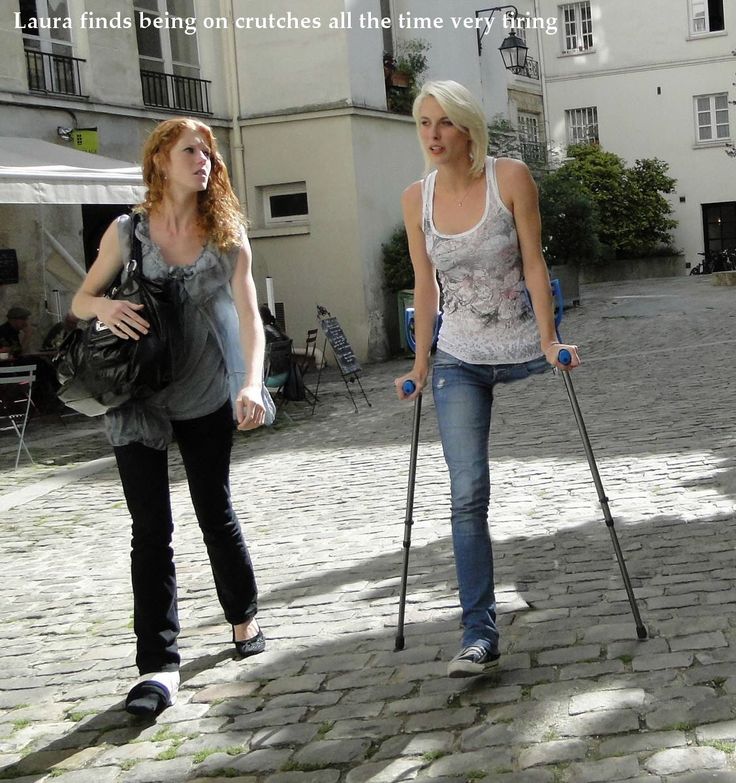
What applies to the general rules of movement on crutches also applies to walking on the arm models. Here you only need to add the exposure of the arms and arm cuffs in height so that it is comfortable to walk. Leaning on a healthy leg, the arms should be bent at the joints by 30 °. Initially, rehabilitation moves on two elbow crutches, at the second and subsequent stages - with one.
Walking rules with underarm crutches are the same as with axillary crutches. The difference is only in the point of support on the hands from the elbows to the wrists. It is more difficult to move around on crutches with support under the elbow.
You need to move up and down the stairs with one crutch, leaning on it with your hand from the side of the sore leg. The hand on the side of the healthy leg should hold on to the railing. An unused crutch must be consistently rearranged in front of you.